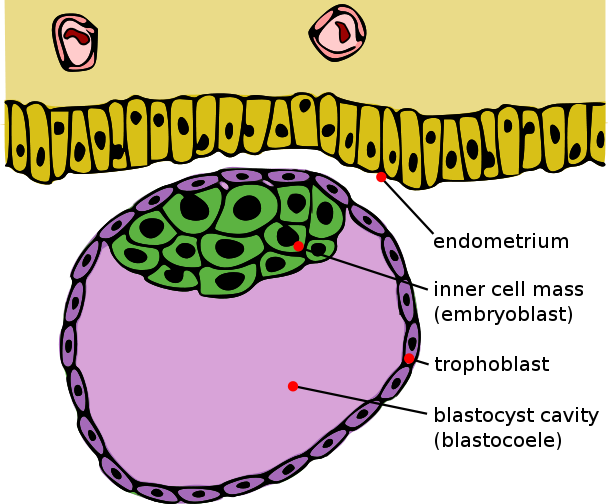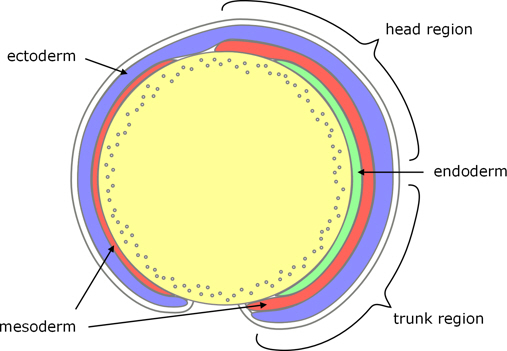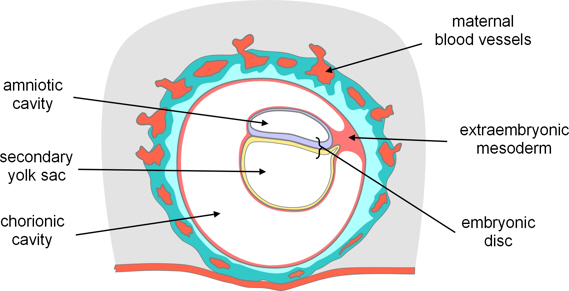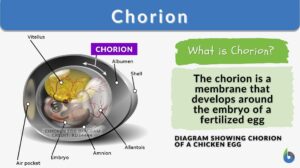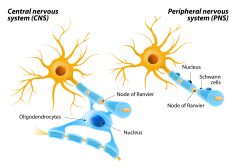
Chorion
n., plural: chorios or choria
[ˈkɔɹiɑn]
Definition: The outermost membrane surrounding the embryo
Table of Contents
Chorion Definition
The chorion is a membrane that develops around the developing fertilized egg. It begins to develop during the early stages of pregnancy, particularly after the young embryo implants in the uterine lining (endometrium) and form the germ layers. The chorion’s main job is to protect and nourish the developing baby inside the mother’s womb. It also helps to create a barrier between the mother’s blood and the baby’s blood to prevent any harmful substances from passing through.
The chorion is an important part of the early stages of pregnancy, and without it, a baby cannot develop properly. As the pregnancy progresses, the chorion eventually becomes part of the placenta, which continues to support the baby’s growth and development until birth.
Watch this vid about chorion as part of the human fetal membrane:
The chorion is a membrane that develops around the embryo. It is one of the extraembryonic membranes. In amniotes, it is an extraembryonic membrane around the developing embryo or the fetus. The insect egg also has a chorion that serves as an outer protective membrane. Even plant embryos have a chorion, which is the outer membrane of a seed. In humans, the chorion is part of the placenta. The chorion has projections called chorionic villi involved in the transfer of nutrients from maternal blood to fetal blood. As the embryo develops into a fetus, the chorionic villi develop as well and become a part of the placenta. Thus, the fetal placenta is also referred to as the chorion frondosum.
Etymology: Latin chorion, Ancient Greek khorion (“membrane surrounding the fetus, afterbirth”).
Structure
Understanding the structure of the chorion can give us insight into how it functions in pregnancy. The chorion is a thin, transparent membrane that surrounds the developing embryo. It is made up of several layers of cells, each with its own unique function.
The structure of the chorion is crucial for supporting the growing fetus by providing it with nutrients, oxygen, and protection from harmful substances.
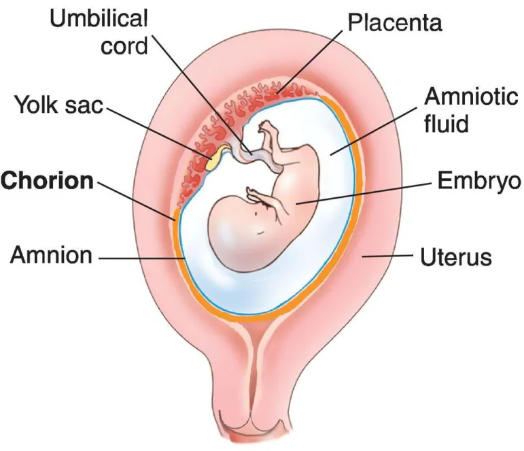
In this section, we will take a closer look at the anatomy of the chorion and the role of each layer of cells in supporting a healthy pregnancy.
Layers
The chorion is made up of several layers of cells, each with its own distinct function. Here are the different layers of the chorion and their roles in supporting a healthy pregnancy:
Trophoblast
The trophoblast is the outermost layer of the chorion, which is one of the membranes that surround the developing embryo in mammals. It is the first structure to form after fertilization and plays a critical role in implantation and establishing the placenta.

Figure 2: Tropoblast layer. Image Credit: DifferenceBetween.com. The trophoblast is composed of two layers — the outer syncytiotrophoblast, which is a multinucleated layer of fused cells, and the inner cytotrophoblast, which consists of individual cells. These two layers work together to create a barrier between maternal and fetal blood circulation and facilitate the exchange of nutrients, gases, and waste products.
The syncytiotrophoblast layer is responsible for invading the maternal endometrium and anchoring the embryo in place. It secretes a range of hormones, including human chorionic gonadotropin (hCG), which is responsible for maintaining the corpus luteum and supporting early pregnancy. The syncytiotrophoblast also produces enzymes that help break down the maternal tissue to create space for the developing embryo.
The cytotrophoblast layer is responsible for generating new cells for the syncytiotrophoblast and plays a key role in forming the chorionic villi, which are finger-like projections that extend into the maternal tissue and increase the surface area for nutrient exchange. These villi are bathed in maternal blood and facilitate the transfer of oxygen, nutrients, and waste products between the mother and the developing embryo.
The chorionic plate is the uppermost layer of the placenta that is in direct contact with the fetus and is responsible for nutrient and gas exchange between the mother and the developing fetus.
Mesoderm
The mesoderm or chorionic mesoderm is one of the three primary germ layers that form during embryonic development, and it plays a vital role in the formation of many different tissues and organs in the body. It is located between the ectoderm (outer layer) and the endoderm (inner layer) of the embryo.

Figure 3: Chorionic Mesoderm. Image Credit: EvolutionUnderTheMicroscope. The mesoderm gives rise to a wide range of tissues, including the muscles, bones, cartilage, connective tissue, blood vessels, and many internal organs, such as the heart, kidneys, and reproductive organs. The mesoderm also plays a critical role in forming the fetal membranes and fetal blood vessels, such as the chorion and the amnion, which protect and nourish the developing fetus.
During development, the mesoderm undergoes a process called mesenchymal condensation, where groups of mesodermal cells aggregate and differentiate into specific cell types. This process is essential for the formation of structures such as the somites, which give rise to the muscles and bones of the body, and the nephrotomes, which give rise to the kidneys.
The mesoderm also forms a layer of connective tissue that surrounds the yolk sac, called the extraembryonic coelom. This chorionic fluid-filled cavity provides a protective environment for the developing embryo and allows for the movement and growth of the embryo.
Extra-embryonic coelom
The extra-embryonic coelom is a fluid-filled chorionic cavity that forms within the extraembryonic mesoderm during embryonic development. It is located outside the embryo and surrounds the yolk sac, providing a protective environment for the developing embryo.

Figure 4: Extra-embryonic Coelom. Image Credit: EvolutionUnderTheMicroscope.com. The extra-embryonic coelom has several important functions during embryonic development. First, it helps to cushion and protect the developing embryo, providing a barrier against external physical forces. Second, it allows for the free movement and growth of the embryo within the extraembryonic membranes. Finally, it provides a space for the developing fetus to accumulate waste products, which can then be eliminated from the body.
The extra-embryonic coelom is also involved in the formation of other important structures, such as the chorion and the amnion. The chorion is the outermost membrane that surrounds the developing embryo, while the amnion is a fluid-filled sac that surrounds the embryo and helps to protect it from mechanical shock and dehydration.
During embryonic development, the extra-embryonic coelom expands and eventually surrounds the entire embryo, forming the embryonic cavity. The embryonic cavity (amniotic cavity) is filled with amniotic fluid, which provides a cushion against physical shock and helps to maintain a constant temperature around the developing embryo.
Endoderm
The endoderm is one of the three primary germ layers that form during embryonic development. It is the innermost layer and gives rise to the lining of the digestive and respiratory tracts, as well as several other organs such as the liver, pancreas, and thyroid gland. The inner surface is vital for the development of these organs.
During embryonic development, the endoderm differentiates into specialized cells that form the lining of the gastrointestinal tract, including the stomach, small intestine, and colon. These cells secrete enzymes and absorb nutrients from food as it passes through the digestive system.
The endoderm is also responsible for the development of the respiratory system, including the lungs, bronchi, and trachea. It forms specialized cells that line the respiratory tract and help transport oxygen from the air into the bloodstream.
In addition to its role in the development of the digestive and respiratory systems, the endoderm is also involved in the formation of several other organs, such as the liver, pancreas, and thyroid gland. The liver produces bile, which helps to break down fats in the digestive system, while the pancreas secretes insulin and other enzymes that regulate blood sugar levels. The thyroid gland produces hormones that regulate metabolism and growth.
Growth
As the fertilized egg travels down the fallopian tube, it will divide until it forms a hollow ball of cells called a blastocyst that will eventually implant in the uterine lining. Trophoblast, the cells on the outer layer of the blastocyst, eventually forms two distinct layers — the cytotrophoblast (inner) and the syncytiotrophoblast (outer) as mentioned above.
The cells of a young embryo continue to divide and form three primary germ layers, the mesoderm, endoderm, and ectoderm. Some cells of the mesoderm will migrate into the space between the cytotrophoblast and the syncytiotrophoblast.
Both the trophoblast and mesoderm contribute to the development of the chorion. In particular, the trophoblast will form the outermost layer whereas the mesoderm helps form the chorionic villi (finger-like projections) that will extend into the uterine lining.
It is around week 4 of pregnancy that the chorion begins to form chorionic villi. These villi help to anchor the embryo in place and facilitate nutrient and waste exchange between the mother and the developing fetus.
As the embryo continues to grow and develop, the chorion also expands and increases in size to accommodate the growing fetus. By week 12 of pregnancy, the chorion has become an integral part of the placenta, which continues to support the developing fetus throughout the remainder of the pregnancy.
Parts
The chorion consists of several parts, each with its own unique function. Here are the different parts of the chorion:
- Chorionic villi: These are finger-like projections that extend from the chorion into the lining of the uterus. The chorionic villus plays a crucial role in supporting the developing fetus by increasing the surface area of the placenta, allowing for a greater exchange of nutrients, oxygen, and waste products between the mother and the fetus. Stem cell research has shown promise in potentially using chorionic villi stem cells, which are found in the chorion, for regenerative medicine and treating various diseases.
- Syncytiotrophoblast: This layer of cells is formed by the fusion of trophoblast cells and is responsible for secreting hormones that help to maintain mammal and human pregnancy. The syncytiotrophoblast also acts as a barrier, preventing harmful substances from passing through to the developing embryo.
- Cytotrophoblast: This layer of cells forms a bridge between the syncytiotrophoblast and the embryo. It helps to anchor the embryo in place and plays a role in the development of the placenta.
- Extraembryonic mesoderm: This layer of cells surrounds the embryo and helps to form the amniotic sac, which contains the amniotic fluid that surrounds and protects the developing fetus.
- Chorion frondosum: This is the part of the chorion that contains the chorionic villi. It is located on the side of the placenta that is closest to the fetus and is responsible for absorbing oxygen and nutrients from the mother’s bloodstream.
- Chorion laeve: This is the smooth, outer layer of the chorion that does not contain chorionic villi. It is located on the side of the placenta that is closest to the uterus and helps to anchor the placenta in place.
Monochorionic twins
Monochorionic twins are a type of identical twins that share a single placenta and chorion. While there is another type known as dichorionic which has its own placentas. This occurs when a single fertilized egg splits into two embryos during early development, and the two embryos share the same outer membrane (chorion) and placenta.

Here are some key points about monochorionic twins:
» Monochorionic twins are more common in pregnancies resulting from in vitro fertilization (IVF), where one fertilized egg is transferred to the uterus, compared to spontaneous pregnancies.
» Monochorionic twins share the same blood supply through their shared placenta, which can sometimes result in complications such as twin-to-twin transfusion syndrome (TTTS). This occurs when blood flows unequally between the twins, leading to one twin receiving too much blood and the other not enough.
» Due to their shared placenta, monochorionic twins may have a higher risk of certain complications during pregnancy, such as preterm birth, growth restriction, and developmental abnormalities.
» Monochorionic twins require close monitoring throughout pregnancy to ensure that both babies are growing properly and to detect any potential complications early on.
In some cases, monochorionic twins may need to be delivered early or delivered via cesarean section to reduce the risk of complications.
» Despite the potential challenges, many monochorionic twin pregnancies result in healthy babies, and with proper monitoring and medical care, many complications can be managed successfully.
Infections
Chorion infections refer to infections that affect the chorion, the outer membrane that surrounds the developing fetus during pregnancy. These infections can be caused by a variety of microorganisms, including bacteria (bacterial infection), viruses, and fungi.
Here are some key points about chorion infections:
» Chorion infections can occur at any point during pregnancy, but they are most common during the second and third trimesters. Some common causes of chorion infections include group B streptococcus, chlamydia, gonorrhea, cytomegalovirus (CMV), and herpes simplex virus (HSV).
» Chorion infections can lead to a variety of complications, including preterm labor, premature rupture of membranes, fetal growth restriction, and fetal death. Symptoms of chorion infections can vary depending on the type of infection and its severity but may include fever, abdominal pain, vaginal discharge, and bleeding.
» Chorion infections are typically diagnosed through a combination of physical exams, laboratory tests, and imaging studies. Treatment for chorion infections may involve antibiotics or antiviral medications, depending on the underlying cause of the infection.
In some cases, chorion infections may require hospitalization and close monitoring to ensure the health and safety of both the mother and the developing fetus.
Chorion Function
The chorion, an important part of the reproductive system, serves several crucial functions during pregnancy. Here are the key functions of the chorion:
Protection
The chorion acts as a protective barrier, shielding the developing embryo/fetus from potential harm. It helps prevent the entry of harmful substances, such as certain toxins or pathogens, from reaching the embryo/fetus.
Nutrient and Gas Exchange
The chorion facilitates the exchange of essential nutrients, oxygen, and waste products between the mother and the developing embryo/fetus. It allows the transfer of nutrients and oxygen from the mother’s bloodstream to the developing fetus while removing waste products from the fetal circulation.
Hormone Production
Specialized cells within the chorion, such as the syncytiotrophoblast, produce hormones that are vital for maintaining pregnancy. These hormones include human chorionic gonadotropin (hCG), progesterone, and estrogen, which help support the growth and development of the fetus and play a role in regulating the mother’s physiological changes during pregnancy.
Anchoring and Implantation
The chorion helps anchor the embryo/fetus within the uterus, preventing it from moving or dislodging. It plays a crucial role in the implantation process by attaching the fertilized egg to the uterine wall and establishing a connection for nutrient and oxygen supply.
Development of the Placenta
The placenta consists of two sides — the embryonic side/fetal compartment (trophoblast and chorionic villi) and the maternal side (develops from the decidua basalis of the uterus). During embryonic development, the embryonic portion of the placenta comes from the outermost membrane, the chorion. It contributes to the growth of chorionic villi, finger-like projections that extend into the uterine lining and increase the surface area for nutrient exchange between the mother and the developing fetus.
Chorion Development
The development of the chorion, the outermost membrane that surrounds the developing embryo/fetus, is a complex and dynamic process that occurs during early pregnancy. Here are the key stages of chorion development:
Formation
The chorion begins to form shortly after fertilization, around the time of implantation. It develops from cells of the trophoblast, the outer layer of cells in the blastocyst, a hollow ball of cells that will eventually give rise to the embryo and other fetal membranes.
Villous Stage
During the villous stage, which begins around week 2 of pregnancy, finger-like projections known as chorionic villi begin to form on the surface of the chorion. These villi extend into the uterine lining and provide a large surface area for nutrient and gas exchange between the mother and the developing embryo/fetus. Secondary villi are finger-like projections that develop from primary villi in the chorion during the second month of pregnancy and further increase the surface area for nutrient and gas exchange between the mother and the developing fetus.
Vascularization
As the villi continue to develop, they become increasingly vascularized, meaning they are supplied with blood vessels. This allows for the exchange of oxygen and nutrients between the mother and the developing fetus.
Fusion
During the fourth week of pregnancy, the chorion fuses with the amnion, the innermost membrane that surrounds the developing embryo/fetus. This forms the chorion-amnion membrane, which helps protect and cushion the developing fetus.
Maturation
Over the course of pregnancy, the chorion undergoes further maturation and development, helping to support the growth and development of the developing fetus. The chorionic villi continue to grow and branch, providing an increased surface area for nutrient and gas exchange. The chorion also produces important hormones, such as human chorionic gonadotropin (hCG), progesterone, and estrogen, which are vital for maintaining pregnancy. The embryonic pole is the portion of the developing embryo or fetus that will eventually give rise to the head and trunk.
Chorion gene expression is a complex process that involves the activation and regulation of specific genes in the chorion, which play a vital role in fetal development and survival.
Chorion in Monotremes and in Non-Mammals
In monotremes, which are a group of egg-laying mammals, the chorion plays a slightly different role than it does in placental mammals.
Monotremes have a less developed chorion, which does not contribute to the formation of a placenta. Instead, the chorion helps to form the shell membrane that surrounds the egg. The chorion in monotremes is thin and transparent and allows for gas exchange between the developing embryo and the external environment.
In non-mammals, the chorion is a part of the eggshell, which surrounds the developing embryo. The chorion is formed by follicular cells in the ovary and provides a protective layer around the egg. It is made up of proteins and other materials that provide strength and flexibility to the eggshell. The chorion in non-mammals also allows for gas exchange between the developing embryo and the external environment.
Note it! What is the importance of the extra-embryonic coelom in embryonic development?
The extra-embryonic coelom provides a protective environment for the developing embryo, allows for free movement and growth, helps to eliminate waste products, and is involved in the formation of important structures such as the chorion and the amnion, which help to protect and nourish the developing fetus.
Take the Chorion – Biology Quiz!
References
- Go, Y. Y., Chae, S. W., & Song, J. J. (2021). Osteogenic effects of exosomes derived from human chorion membrane extracts. Biomaterials Research, 25(1), 1-6.
- Gridelet, V., Perrier d’Hauterive, S., Polese, B., Foidart, J. M., Nisolle, M., & Geenen, V. (2020). Human chorionic gonadotrophin: new pleiotropic functions for an “old” hormone during pregnancy. Frontiers in Immunology, 11, 343.
©BiologyOnline.com. Content provided and moderated by Biology Online Editors.
